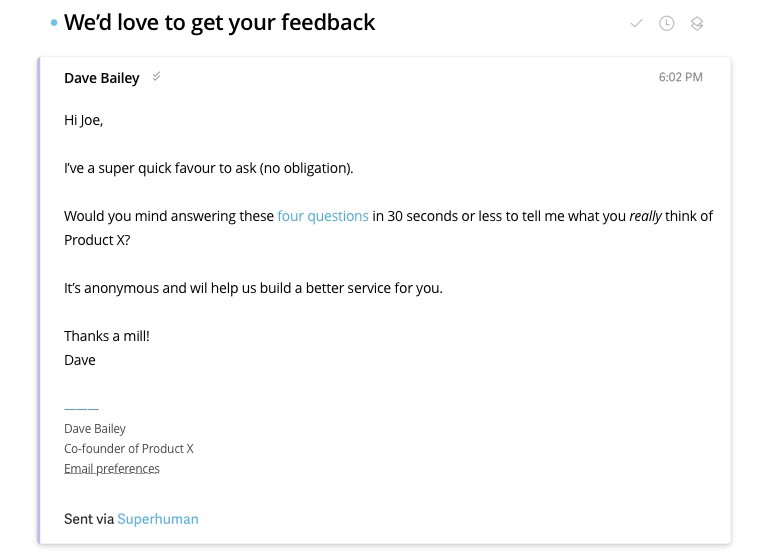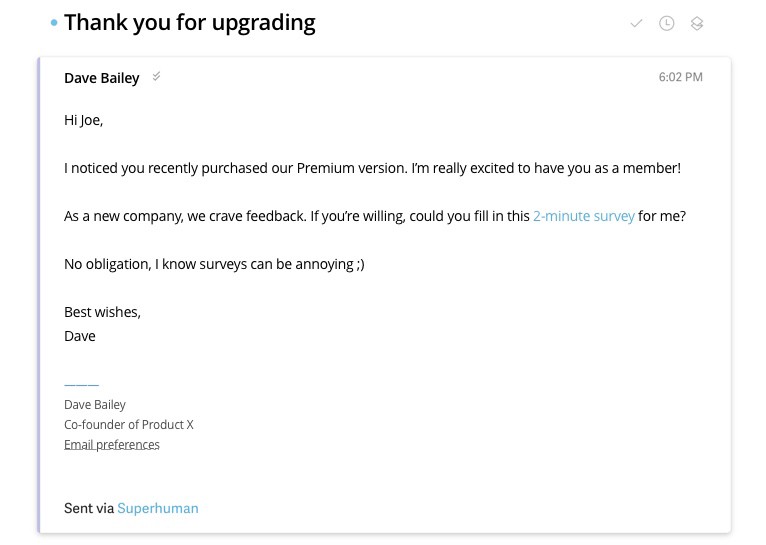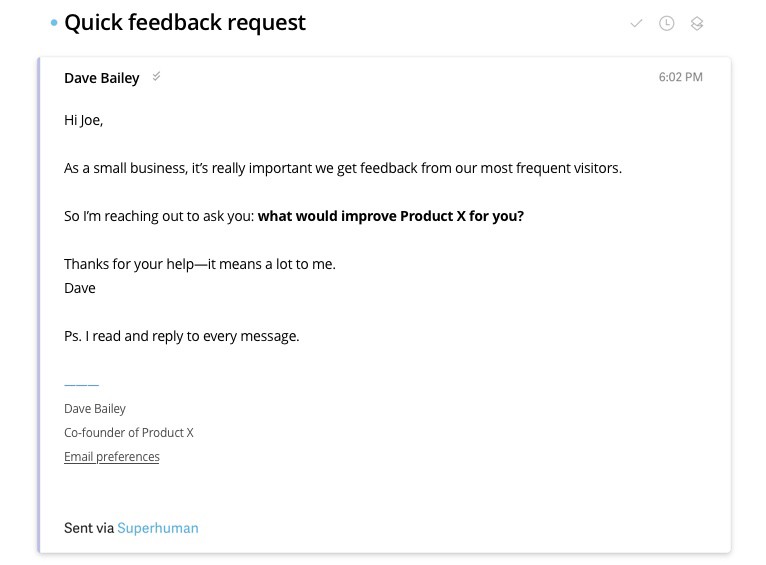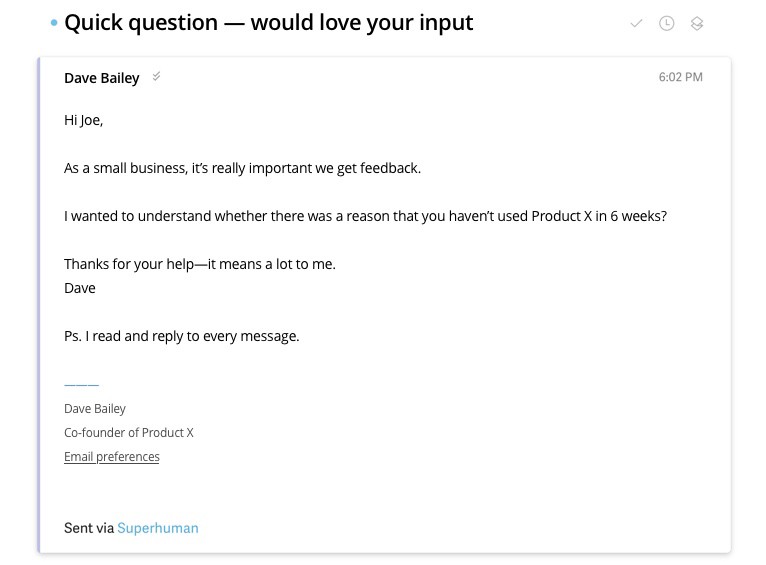How Startups Can Automate Customer Feedback
Written by Dave Bailey

Find out how you can measure product-market fit by using automated outreach to connect with customers more regularly and efficiently.
Here is a fast and effective way to create a continuous stream of customer feedback that helps you build a product they will love.
I used to spend about 45 minutes on a customer interview, where I went deep into their existing behaviours, frustrations, and worldview. I listened for insights and wrote down direct quotes to save for later.
But after the first few months of product development, I found myself spending less time interacting with customers and more time building. Most of my customer feedback was second-hand information from my team.
Learn new skills every week ->
Big insights can come in small packages
I was looking for an easier way to have regular contact with customers in smaller chunks. That’s when I stumbled on Rahul Vohra’s blog post, How Superhuman Built an Engine to Find Product/Market Fit, where he shares a survey that he uses to quantify a product/market fit. However, what caught my attention wasn’t the quantitative metric, it was his use of open questions to automated direct feedback from customers.
Within 10 minutes of reading the essay, I had already implemented the first step of what has become a multi-step process that provides a stream of quotes and insights from my customers.
My automated customer feedback system
Over the last year, I’ve been working on a simple and effective system to automate customer insights. I focus on six key touchpoints:
- Founder reach out — an email one day after sign up
- Product/market fit survey — a survey two weeks after sign up
- Purchase survey — a survey one hour after purchasing
- Cancellation survey — a survey during the cancellation process
- Heavy usage feedback — an email after heavy usage of the product
- Inactivity feedback — an email after a period of inactivity.
Let’s look more closely at each of these. I’ll show you the questions I ask my customers, and explain what I’m trying to achieve.
1. Founder reach out
As with most online products, when a customer signs up for my mailing list or product, they receive an automated welcome email that shares some extra information about the product. However, I send another email 24 hours after a user signs up, with a personal hello from the founder.
This email has one main objective: to start a conversation. I keep the email unstyled and ask an ice-breaking question that encourages people to respond.

Ice-breakers that I’ve used include:
- Where did you find out about us?
- How was your first impression of the product?
- What convinced you to sign up?
In order to keep track of how people respond, I use CloudHQ to add their responses to a Google Sheet, identifying the email by its subject. This helps me quickly review and analyse them later on.
2. Product/market fit survey
According to Sean Ellis, you’ve reached product/market fit when 40% of your customers would be ‘very disappointed’ if they couldn’t use your product.
Fifteen days after a user signs up, they receive a request to answer the following survey questions:
- How would you feel if you could no longer use [product name]?
- What type of people do you think would most benefit from [product name]?
- What is the main benefit you receive from [product name]?
- How can we improve [product name] for you?
The first question requires the user to choose from a list of options:
- Very disappointed
- Somewhat disappointed
- Not disappointed
All other questions are left intentionally open, to ensure I learn new things and capture my users’ natural way of expressing themselves.

Given the relatively small percentage of people who answer surveys, I’ve found it easy enough to manually categorise their answers to provide quantitative results — to find out which improvement ideas are most frequent, for example.
A quick note on NPS: I used to ask my users the Net Promoter Score question: ‘How likely are you to recommend [product name] to a friend?’ I ended up switching because I prefer Sean Ellis’s product/market fit metric and the clarity that the 40% target provides.
3. Purchase survey
Getting inside your customers’ heads at the moment of purchase is incredibly insightful. So, an hour after they’ve made a purchase on the website, I send another survey to my users. Here’s my email template:

I’ve based my questions on an article by Andy Raskin: Why Great Pitches Come From Customers. They sound a little strange when you read them, but the answers to them have been incredibly interesting.
- How do you imagine [product name] would change your life?
- What has changed in the world such that what you just described is more valuable than it would have been, say, 5 or 10 years ago?
- What does ‘winning’ look like for you when it comes to [activity]?
- . . . and how about ‘losing’?
- What are your biggest obstacles to winning?
The output of this survey not only helps me understand the urgency and expectations around purchasing, it helps me craft better sales pitches and ad copy for my product.
4. Cancellation surveys
It’s important to know why people decide to stop using your product, so I’ve incorporated a short feedback survey into the cancellation process. While I make answers optional, asking these questions before the cancellation is finalised has led to a higher response rate.
The questions I ask are:
- What were your expectations of [product name] that we didn’t meet?
- How could we improve the product that would change your mind?
Cancelling customers also receive a short ‘Sorry to see you go’ email, directly from me, in which I ask one more time for feedback on what we could have done better.
5. Heavy user feedback
According to Sam Altman of YCombinator, ‘It’s better to build something that a small number of users love, than a large number of users like.’ I figured out a usage metric that identified our power users — for example, those visiting the website five times in ten days — and I use that to fire off a feedback email:

Again, my intention isn’t to ask loads of questions, it’s to start a conversation.
Learn new skills every week ->
6. Inactivity feedback
In the same way that I target heavy users to provide feedback, I do the same for people who stop using the website. After six weeks of inactivity, the following email is triggered:

Getting feedback from people that don’t use the website is interesting, but I take care to weight their feedback appropriately. You can’t please everyone all of the time — and listening to people that aren’t your target has the potential to lead you astray. Ask yourself: is this really a potential customer?
How to use the data
There are lots of ways to use the insights from automated user outreach data. Here are some of the highest-value uses:
- Ad copy: It’s a powerful strategy, to play your customers’ words back to them. Some of my best ad copy has been inspired by answers to the question, ‘What does “winning” look like for you when it comes to [activity]?’
- Testimonials: I’ve gathered hundreds of up-to-date testimonials of happy clients from these automated flows. Occasionally, a user will share a personal story about our product that really motivates us to keep going during the hard times.
- New feature ideas: Insights are ‘aha moments’, where you understand user behaviour in a new way. When you find an interesting quote from a customer that seems insightful, ask yourself: ‘How can we use this to create a beautiful feature?’
- Testing specific assumptions: During product development, questions always come up about customers. It’s easy to change the ice-breaker questions in the emails, or add a short question to a survey, in order to get quick input from real customers.
To make the data easy to manage, I link all of the forms and Zaps into a single Google Sheets file which I can analyse easily. Here’s how my spreadsheet is structured, along with some charts.
Set it or you’ll regret it!
Creating an automated feedback flow doesn’t take long if you’re using email tools like MailChimp, Sendgrid or Mailgun. But the benefits of continuous organic contact with your customers are hard to overstate.
Customer feedback will increase your understanding of their needs, help you learn how to attract new customers, and how to keep your existing ones happy — all critical if you want to reach product/market fit.
Continue reading about customer feedback:
- Launching an exciting new product? Here’s a checklist to help you develop great product ideas.
- Want to increase your sales? Start with your existing client base. Use this research process to understand your customer.
- Struggling to price your product? Learn about the best pricing techniques to help you make the final decision.
Originally published May 7, 2019, last updated Apr 9, 2024
Learn a new skill every week
Subscribe to my weekly newsletter and learn new skills and mental frameworks that make startup life easier.
Unsubscribe any time.





